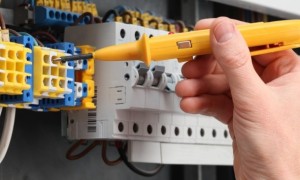Does Your Electrical Switchboard Need Upgrading?
March 18, 2017 - 4 minutes read It goes without saying that our modern demands of electrical power are very different from that of the past. Our predecessors for instance didn’t run multiple computers, giant TVs, air conditioners, and / or complex lighting and sound systems!
It goes without saying that our modern demands of electrical power are very different from that of the past. Our predecessors for instance didn’t run multiple computers, giant TVs, air conditioners, and / or complex lighting and sound systems!
Our modern power demands make it essential to make sure your building’s electrical switchboard is up to the tasks required of it, and that other precautions are also taken in order to avoid electrical overheating, fires, and electric shock.
Common causes of overheating
When electrical energy is generated, it converts to other forms of energy – such as light, mechanical energy, or heat (measured in watts). When overheating occurs, an appliance, plug or socket may burn out, or an electrical fire may result if there is combustible material nearby to act as a source of fuel. It’s estimated that as many as 20% of building fires are caused by electrical faults.
Some of the common causes are:
- Loose connections – these might occur due to thermal stress, vibration, or contamination and corrosion, and can lead to increased resistance, insulation failure and an increase in generated heat.
- Insulation damage – while modern standards for insulation are higher than in the past, over time insulation can still degrade. In cases where loose connections are present, arcing (electrical discharges across an air gap) may occur and cause an increase in heat generation.
- Excess current – although this is less common these days, it can still happen in the case of an outdated switchboard (see below) and wiring.
Your switchboard may need an upgrade if:
- It contains older-style ceramic or rewireable fuses.
- Blown fuses or circuit-breaker trips are occurring regularly.
- Your lights often flicker on and off.
- Safety switches or RCDs (Residual Current Devices) have not been installed.
Safety switches in particular can act as life-savers. These devices are designed to interrupt the power supply if current leakage is detected due to faulty wiring or an appliance fault, protecting you from electric shock. While the laws regarding safety switches vary from one state to another, they are mandatory in all states when it comes to new builds. Other important devices include circuit breakers to provide protection from excess current and potential electrical fires, and surge diverters – usually used to redirect voltage surges during a lightning strike.
Electrical testing
If you’re not sure of the state of your switchboard, wiring or electrical systems, or you are noticing either some of the problems listed above or charring or overheating smells from electrical components, then it’s vital to have some professional electrical testing done. Various types of tests (such as thermography, voltmeters and insulation testing) may be used to detect loose connections, connection resistance problems and other faults.
But in any case, safety switches should be installed – preferably on all power and lighting circuits and certainly as per state regulations.
Other tips for electrical safety and fire prevention
- Always use electrical equipment according to manufacturer instructions.
- Keep all your electrical equipment clean, dry, cool, and free of dust.
- Avoid using extension cords and double-adapters long term – they should provide a temporary solution only.
- Do not use power outlets that are loose, noisy or hot to touch, or cords that are frayed or damaged.
- Only ever use properly licenced electricians for electrical work.
For more information on this topic, see our previous posts on electrical safety practices and on the importance of regular electrical testing and tagging of your appliances and equipment.
Written by Tess Oliver
Tags: asset protection, Electricity, fire
Recent Comments